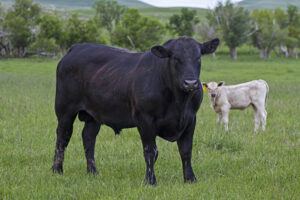EPDs: What Do All Those Numbers Mean?
This is a guest post written by Karin Schmid, Beef Production Specialist with the Alberta Beef Producers.

Bull buying season is upon us. If your house is anything like my family’s, most available surfaces are now piled high with catalogues advertising the next great herdsire.
There are many factors that play a role in choosing a new bull for your operation (visual observation, breed, pedigree, actual birth weight, residual feed intake (RFI), weaning weights, breeding soundness evaluation, etc.), but one tool that can aid in herdsire selection has led to a lot of confusion since its first use over 40 years ago. Let’s decipher this valuable tool so you can expertly evaluate potential herdsires as you flip through those sale catalogues.
EPDs defined
Expected Progeny Differences (EPDs) are estimates of an animal’s genetic merit as a parent. EPDs are the difference between the predicted average performance of an animal’s future progeny and the average progeny performance of another animal whose EPD is zero, assuming that the bulls are mated to similar cows, or vice versa. For example, if Bull A has a birthweight EPD of +9.0 lbs and Bull B has a birthweight EPD of +3.0 lbs, this means that Bull A’s calves will have birthweights that are 6 lbs heavier than whatever the birthweight of Bull B’s calves are, on average.
To compensate for differences in environment and management, contemporary groupings are used. Contemporary groups are animals of the same age and sex raised under the same management conditions. Once these factors are accounted for, the genetic component is the part that remains, and that is what EPDs predict. Information used in computing EPDs includes pedigree and performance of the individual animal, all relatives, and progeny. It is often assumed that EPDs are calculated in much the same way as 205 day adjusted weights, but this is not the case. To correctly calculate EPDs, millions of equations must be solved simultaneously.
Many different EPDs exist, from calving ease and weaning weight, to ribeye area and marbling, to cow weight and stayability. EPDs are generally reported in the same units as the traits they measure (pounds for weight traits, square inches for ribeye, etc.).
Differences between breeds

Each breed association publishes various EPDs and indexes, and they are not comparable to each other, as EPDs for each breed have specific breed variations in the way they are calculated. A Charolais weaning weight EPD of 72 lbs does not mean the same thing as an Angus weaning weight EPD of 72 lbs. In addition, breed average EPDs are not necessarily zero, so an EPD above zero may not mean above average. This is why it’s important to know what the breed average numbers are for the breed you are interested in. Some breed associations have genetic evaluations that span multiple countries, in order to compare genetics across borders easily. There are some organizations that produce across-breed EPDs (e.g. Beef Improvement Opportunities), which may be useful in certain situations when bulls of different breeds need to be compared.
Abstract values
It is important to realize that EPDs do not predict individual animal performance, nor do they correspond to any specific value for a particular trait. A weaning weight EPD of 46.6 lbs does not equal an actual weaning weight of 650 lbs for that animal’s progeny. A weaning weight EPD of 46.6 lbs means, on average, that animal’s progeny will weigh 46.6 lbs more than the progeny of a different animal with a weaning weight EPD of 0 lbs (or 20 lbs more than the progeny of a different animal with a weaning weight EPD of 26.6 lbs).
A bull with impressive EPDs does not guarantee a superior calf crop. A common producer complaint about EPDs is that they do not seem to reflect actual data. Because EPDs rely on information provided by the producer, it is critical that the accurate information is submitted. This means reporting all performance data measured on all animals in the herd, and correctly identifying contemporary groups under different management (like creep feed). In addition, billions of genetically different progeny are possible from just a single mating! There are plenty of genetic differences between full siblings. Because EPDs predict average progeny performance, it is quite common to have a calf or two that doesn’t fit in with the rest. This is where accuracy comes in.
Accuracy of predictions
Accuracy is a value between 0 and 1 that reflects how close the prediction (EPD) is to the true genetic merit (breeding value) of the animal. Accuracy values increase as the amount of information known on an animal increases. Adding data on an animal’s own performance, the performance of its relatives, and performance of its progeny will increase accuracy. As accuracy gets higher, an EPD is less likely to change a substantially. Breed associations have possible change tables, which indicate how much an EPD may change (either up or down) with the addition of new information. Young animals generally have low accuracy, because the association doesn’t have any progeny information recorded yet, while A.I. sires with lots of progeny generally have quite high accuracies, indicating more confidence in EPD values.
Some breed associations are incorporating genomic data into their EPD evaluations. By merging DNA test results with the traditional EPDs, more information can be added at a younger age, increasing the accuracy (and confidence) in that animal’s EPDs. For traits with high heritability, adding genomic data can increase accuracy by the same amount as adding data from 7-20 progeny, if the original animal only has pedigree data.
Heritability: the proportion of variation in a particular trait that can be attributed to inherited genetic factors as opposed to environmental factors. Reproductive traits tend to be lowly heritable, while weight and carcass traits are more heritable.
Example
| Bull A | Bull B | |
|---|---|---|
| Calf #1 | 700 lbs | 625 lbs |
| Calf #2 | 600 lbs | 615 lbs |
| Calf #3 | 605 lbs | 650 lbs |
| Calf #4 | 610 lbs | 640 lbs |
| Average adjusted weaning weight | 628.8 | 632.5 |
| Sire weaning weight EPD | 51.7 (accuracy = 0.75) | 56.0 (accuracy = 0.75) |
The difference in the two bull’s weaning weight EPDs is 4.3 lbs, which is very close to the difference between the average adjusted weaning weights of their calves in the example. Even though Bull A has the calf with the highest weaning weight, the rest of his calves show that his EPD should be lower than Bull B’s EPD. Large contemporary groupings and large numbers of progeny in general (or genomic data in some cases) will result in an EPD that reflects actual data much more closely.
Balanced approach to selecting traits
One last important point is to avoid single trait selection! Although all these numbers can get confusing, selection based upon a single trait can often lead to undesired consequences. For example, selecting only for weaning weight in a production system where heifers are retained, will lead to larger mature cows, potential calving difficulties, and perhaps decreased fertility. A balanced selection approach focusing on optimizing traits for your environment and production system works much better than trying to maximize a single trait. Many breeds produce indexes to reflect a certain production system (i.e. terminal vs. maternal) that combine the economically relevant EPDs for that production system into one number.
EPDs are the best tool we have for estimating genetic merit of an animal. On younger animals with low accuracy, they can be used to narrow down the possible herdbull choices by eliminating the bulls with the poorest EPDs, or deciding between a few favourite bulls. On higher accuracy animals, like A.I. sires, where visual appraisal is often not possible, they can be used with a reasonable amount of confidence.
For more information:
- Breed Associations (Canadian Beef Breeds Council)
- Sire Selection Manual (National Beef Cattle Evaluation Consortium)
- Using Expected Progeny Differences in a Breeding Program (Manitoba Agriculture)
The sharing or reprinting of BCRC Blog articles is welcome and encouraged. Please provide acknowledgement to the Beef Cattle Research Council and list the website address, www.BeefResearch.ca.
We welcome your questions, comments and suggestions. Contact us directly at [email protected] or generate public discussion by posting your thoughts below.
Stay connected by following us on Twitter @BeefResearch, liking us on Facebook, and subscribing to our YouTube Channel.